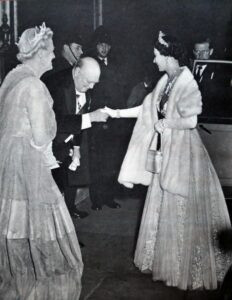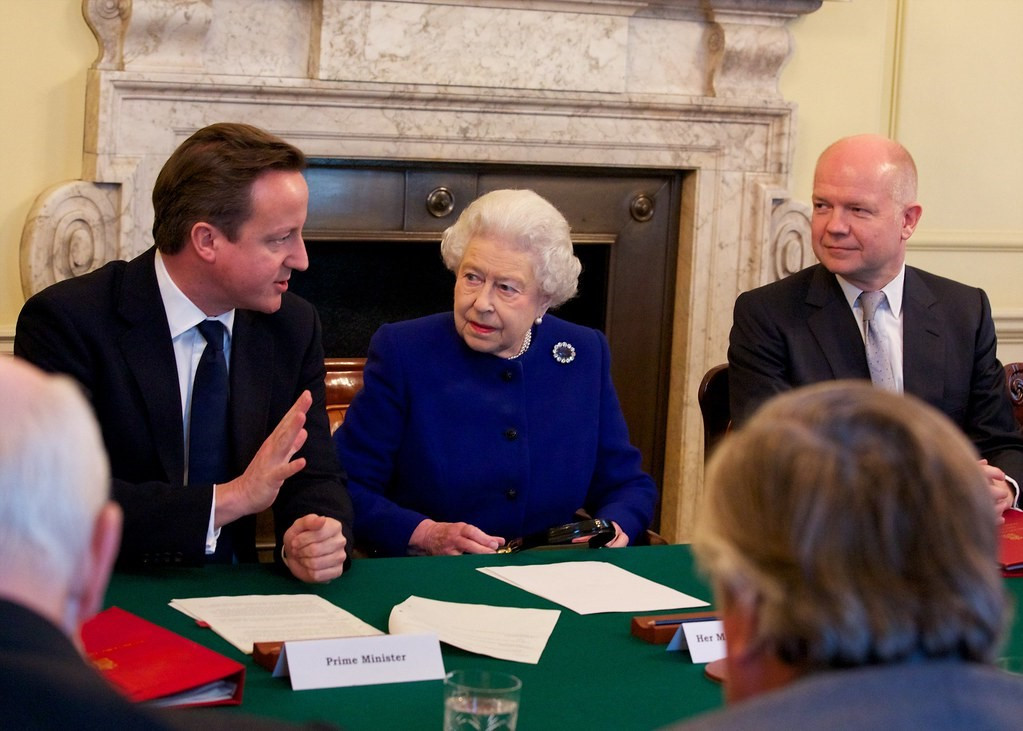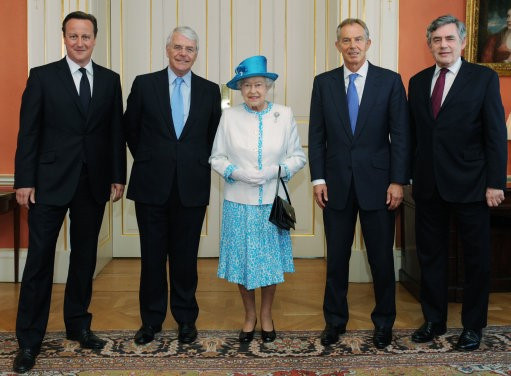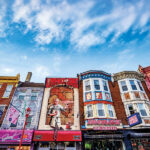Downing Street in London stands as a symbol of British political power, and for seventy glorious years, Queen Elizabeth II’s reign has been interwoven with its history. From Winston Churchill to Boris Johnson, fourteen Prime Ministers have crossed the threshold of No. 10 Downing Street to meet with the Queen, each bringing their unique perspective to the weekly audience, a cornerstone of the British political system. This enduring relationship, characterized by discretion and mutual respect, has seen Downing Street play host to historic encounters and significant moments in the Queen’s long reign.
The weekly audience between the monarch and the Prime Minister is a deeply private affair, a convention that has been treasured by successive leaders. Harold Macmillan, early in his premiership, confided in the Queen about his government’s uncertain future. Six years later, she playfully reminded him of his initial apprehension, highlighting the Queen’s remarkable memory and the personal nature of these meetings. For Macmillan, the Queen was “a great support,” providing a confidential sounding board unlike any other. Edward Heath echoed this sentiment, valuing his audiences as a “relief” and an opportunity for completely confidential discussions with the head of state.
Downing Street has not only been a place for private counsel but also a stage for public celebrations and significant milestones in the Queen’s reign. Let’s revisit some memorable occasions where the paths of the Queen and Downing Street intersected.
 Queen Elizabeth II with Winston Churchill at 10 Downing Street, reflecting the start of a long and historical relationship.
Queen Elizabeth II with Winston Churchill at 10 Downing Street, reflecting the start of a long and historical relationship.
In April 1955, 10 Downing Street’s State Dining Room was the venue for a dinner hosted by outgoing Prime Minister Winston Churchill in honor of the Queen. This was a poignant evening, marking Churchill’s departure from office after a distinguished career. On the eve of his resignation, Churchill, the wartime leader, raised a toast to the Queen, reminiscing about his early military days under Queen Victoria, her great-great-grandmother. John Colville, Churchill’s Private Secretary, described the event as “splendid,” with Lady Churchill ensuring a lavish meal and Downing Street adorned in its finest for the distinguished gathering of ministers and officials.
Harold Wilson, who became the Queen’s first Labour Prime Minister in 1964, developed a warm rapport with the monarch despite their different backgrounds. Wilson, a respecter of tradition, appreciated the ceremonies of the Monarchy. He often stressed the need for Prime Ministers to be well-prepared for their audiences, as the Queen was remarkably well-informed and astute. Their meetings reportedly extended to two hours, indicating a deep and engaging dialogue between them. Decades after Churchill’s farewell dinner, Wilson, upon his own resignation in 1976, chose to host the Queen at Downing Street for a farewell dinner, mirroring Churchill’s earlier gesture.
Edward Heath, during his time as Prime Minister in the early 1970s, orchestrated a unique musical evening at Downing Street to celebrate composer William Walton’s 70th birthday. The Queen and Queen Mother were among the esteemed guests, alongside musical luminaries like Sir Arthur Bliss and Laurence Olivier. Following dinner, guests were treated to a performance of Schubert’s B Flat Trio in the Pillared Room, performed by leading musicians from the London Symphony Orchestra, creating a memorable cultural event within the walls of Downing Street.
As the Silver Jubilee approached in 1977, Prime Minister James Callaghan highlighted the unifying role of the monarchy. He emphasized that the upcoming address was not just to the institution of the Throne but to the Queen as an individual, recognizing her personal contribution to the nation. Margaret Thatcher, then Leader of the Opposition, echoed these sentiments, praising the Queen’s steadfastness and example in a changing world, quoting John Colville’s description of her as “a rock in a sea of troubles.” Callaghan’s Cabinet presented the Queen with a silver coffee pot for the Silver Jubilee. During the presentation at Buckingham Palace, the Queen humorously remarked her relief that it wasn’t a portrait of Callaghan himself, referencing Disraeli’s gift to Queen Victoria. Callaghan recalled the busy summer of the Jubilee, with numerous international summits hosted in London, and noted the Queen’s tireless energy and vivacity in entertaining a constant stream of visitors.
 Queen Elizabeth II and former Prime Ministers at 10 Downing Street in 1985, celebrating 250 years of No.10.
Queen Elizabeth II and former Prime Ministers at 10 Downing Street in 1985, celebrating 250 years of No.10.
While Margaret Thatcher’s long premiership did not coincide with a Jubilee, 1985 marked the 250th anniversary of Robert Walpole’s occupancy of No.10, considered the beginning of the Prime Minister role. Thatcher celebrated this milestone with a grand dinner at Downing Street, inviting the Queen, the Duke of Edinburgh, and former Prime Ministers. In her speech, the Queen playfully noted that her father, King George VI, had visited Downing Street more often by that point in his reign, humorously questioning if she had done something amiss.
In 2002, Downing Street welcomed the Queen for a Golden Jubilee dinner hosted by Prime Minister Tony Blair. Blair, born in the same year as the Queen’s coronation, was reminded by Her Majesty at their first audience, “You are my tenth prime minister. The first was Winston. That was before you were born.” The Golden Jubilee dinner at Downing Street was a reunion of sorts, attended by former Prime Ministers Heath, Callaghan, Thatcher, and Major. The Queen, in a lighthearted moment, remarked on the familiarity of the gathering, “Isn’t it wonderful not to have to be introduced to anyone?” Her Cabinet presented her with a signed silver gilt plate to commemorate the occasion.
 Queen Elizabeth II at the Golden Jubilee dinner in Downing Street, surrounded by Prime Ministers past and present.
Queen Elizabeth II at the Golden Jubilee dinner in Downing Street, surrounded by Prime Ministers past and present.
For her Diamond Jubilee in 2012, Queen Elizabeth II made history by attending a Cabinet meeting at 10 Downing Street, a first in her reign. While she regularly received confidential Cabinet minutes, this was her first time participating in a meeting. She occupied the Prime Minister’s chair and was presented with 60 placemats and the naming of a section of British Antarctic Territory as Queen Elizabeth Land.
 Queen Elizabeth II attending a Cabinet meeting at 10 Downing Street for the first time in 2012, a historic moment.
Queen Elizabeth II attending a Cabinet meeting at 10 Downing Street for the first time in 2012, a historic moment.
 Queen Elizabeth II with Prime Ministers David Cameron, John Major, Tony Blair, and Gordon Brown in the Terracotta Room at Downing Street during her Diamond Jubilee.
Queen Elizabeth II with Prime Ministers David Cameron, John Major, Tony Blair, and Gordon Brown in the Terracotta Room at Downing Street during her Diamond Jubilee.
These highlights illustrate the Queen’s reign as a constant amidst vast change. While her visits to Downing Street may have been infrequent, the Queen’s private counsel to her Prime Ministers over seven decades, rooted in her unparalleled experience and institutional knowledge, has been a continuous and invaluable aspect of British governance. In her own words, she sees herself as a “sponge,” someone to whom Prime Ministers can unburden themselves, share their challenges, and receive impartial advice, offering a different perspective when needed. Downing Street, England, has been a silent witness to this remarkable relationship, a place where history and the present day continually meet under the enduring reign of Queen Elizabeth II.
Dr Michelle Clement is Lecturer and researcher on government reform and delivery at The Strand Group, King’s College London and Researcher in Residence at No.10 Downing Street. Twitter: @MLClem
[1] A Horne, ‘Macmillan 1957-1986: volume 2 of the official biography’ (London: Macmillan, 1989), page 4
[2] Horne (1989), page 168
[3] E Heath, ‘The course of my life: my autobiography’ (London: Hodder & Stoughton, 1998), page 317
[4] RJ Minney, ‘No.10 Downing Street, a house in history’ (London: Cassell, 1963), page 421
[5] A Seldon, ’10 Downing Street: the illustrated history’ (London: HarperCollinsIllustrated, 1999), page 145
[6] B Pimlott, ‘The Queen: Elizabeth II and the monarchy’ (London: HarperPress, 2012), page 397
[7] B Pimlott, ‘The Queen: Elizabeth II and the monarchy’ (London: HarperPress, 2012), page 397
[8] B Pimlott, ‘Harold Wilson’ (London: William Collins, 2016), page 7
[9] Seldon (1999), page 194
[10] Seldon (1999), page 195
[11] Address to Her Majesty (Silver Jubilee), 3 May 1977
[12] Address to Her Majesty (Silver Jubilee), 3 May 1977, quoting John Colville, ‘The New Elizabethans’ (London: Collins, 1977), page 10
[13] J Callaghan, ‘Time and chance’ (London: Collins, 1987), page 462
[14] Callaghan (1987), page 481
[15] J Brown, No.10: ‘The geography of power at Downing Street’ (London: Haus Publishing, 2019), page 93
[16] Seldon (1999), page 90-91
[17] T Blair, ‘A journey’ (London: Hutchinson, 2010), page 14
[18] A Campbell, ‘The Alastair Campbell diaries volume 4, the burden of power: countdown to Iraq’ (London: Arrow, 2013), page 219
[19] V Low and M Savage, ‘Queen to attend Cabinet to mark Jubilee’, The Times, 18 December 2012
[20] P Hennessy, ‘The hidden wiring: unearthing the British constitution’ (London: Victor Gollancz, 1995), page 69
Tags: Monarchy, Prime Ministers, Queen Elizabeth II

